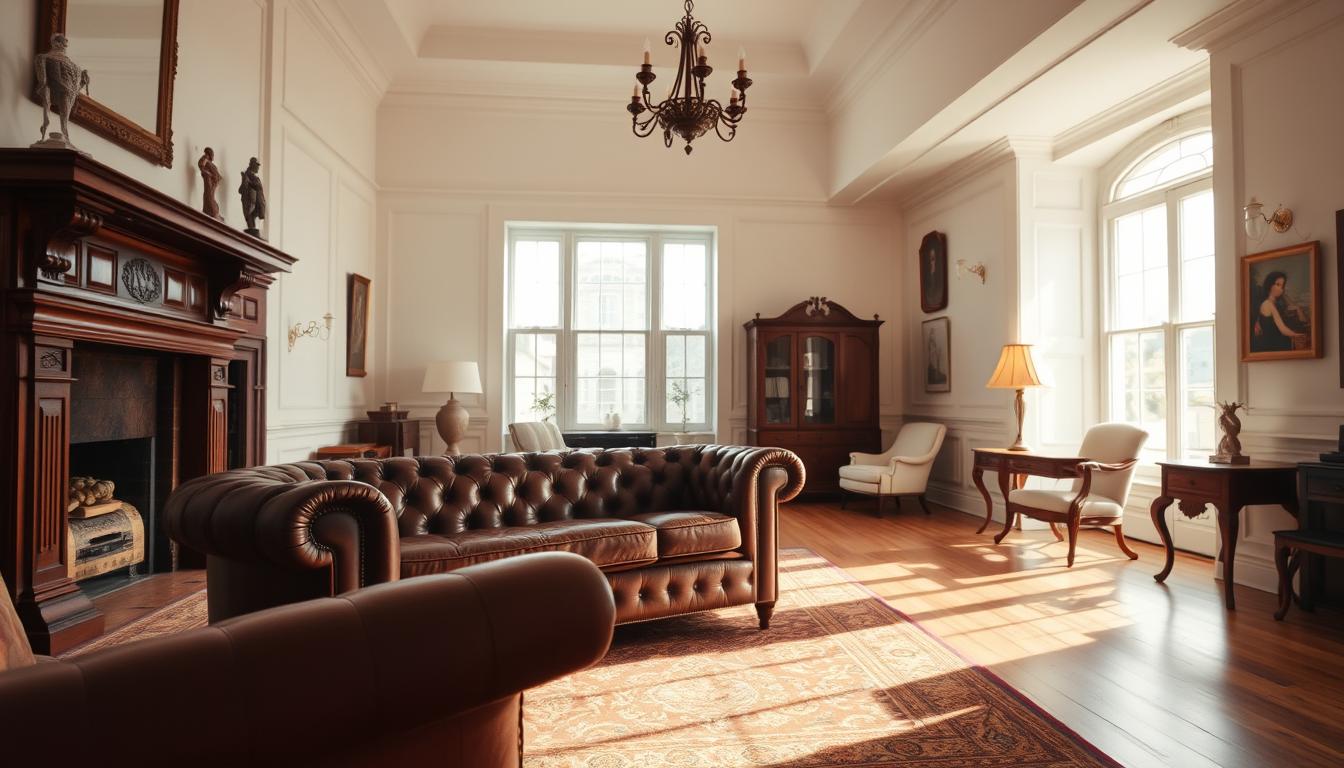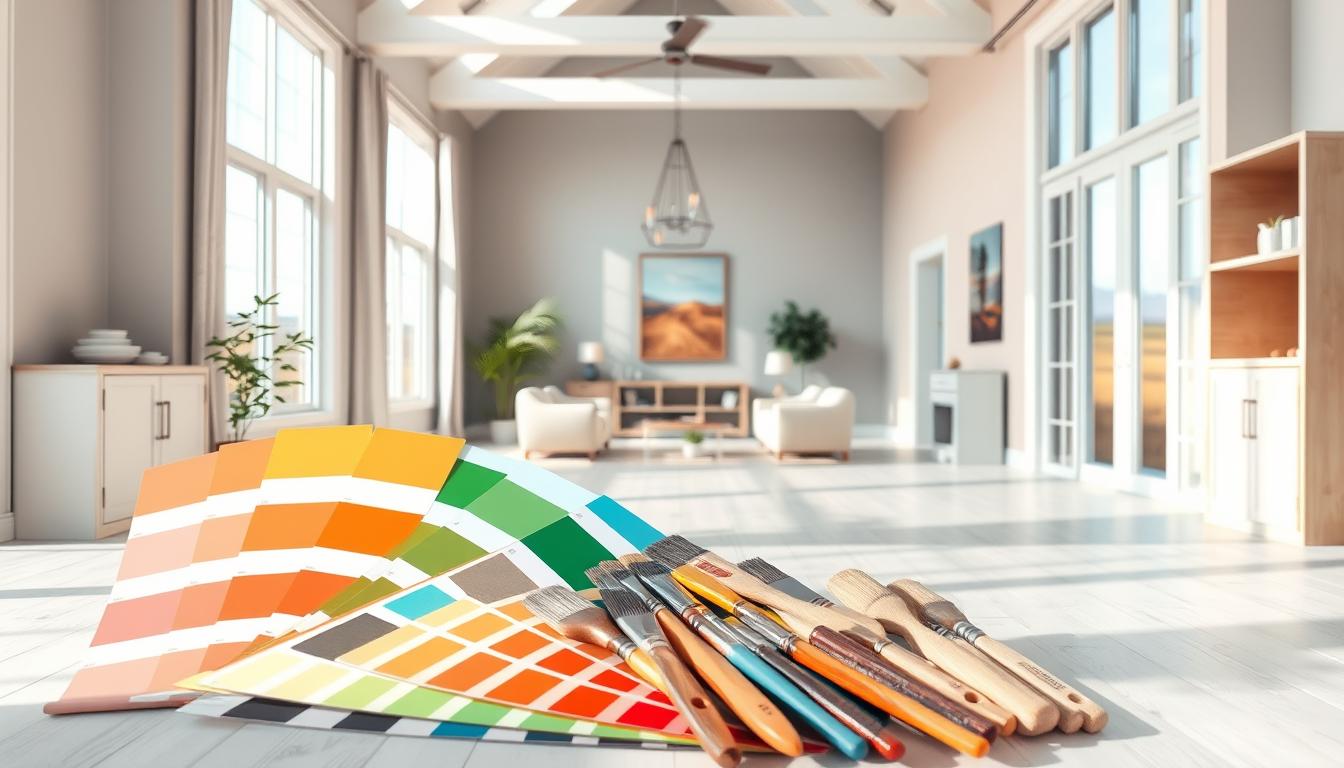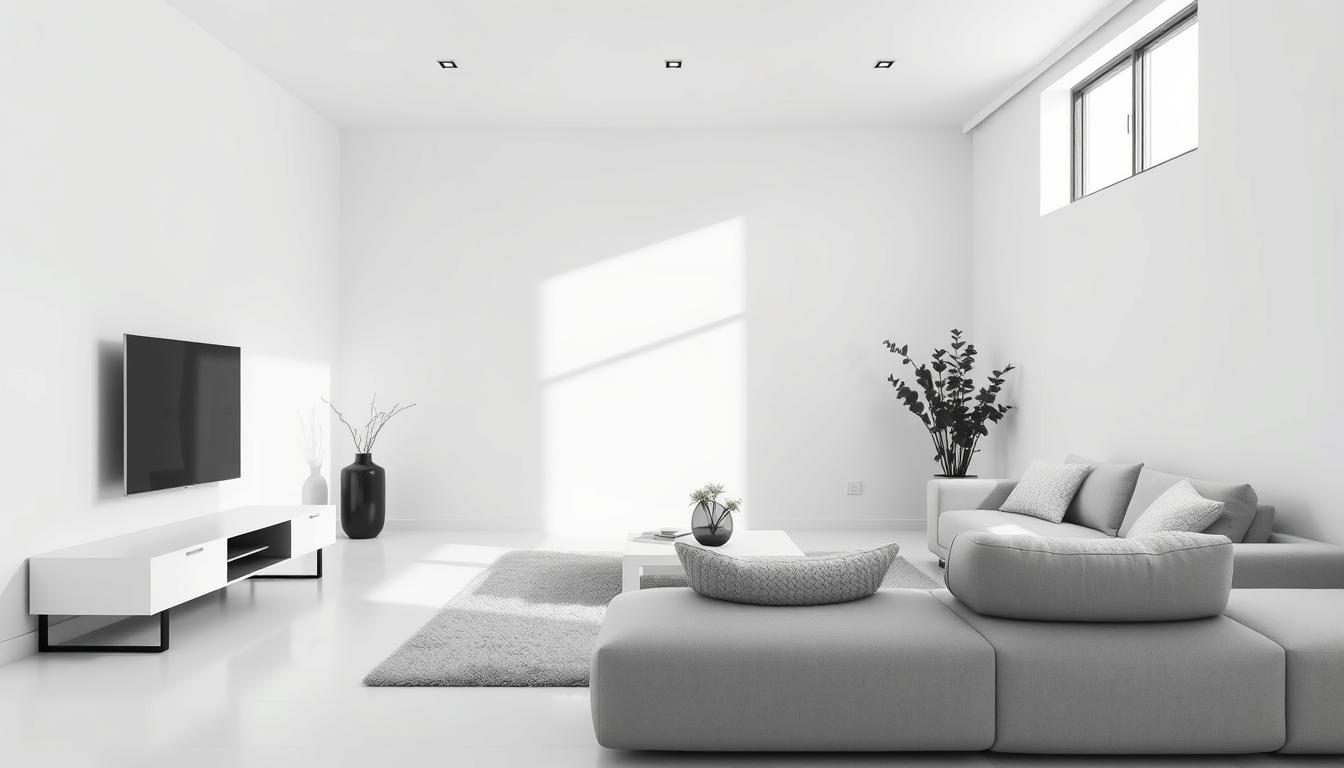Colonial-style homes have been a key part of American architecture for centuries. They bring a sense of tradition and elegance. Their interiors, with classic elements and timeless design, still inspire homeowners today.
The charm of classic colonial architecture comes from mixing history with modern comforts. Exploring what makes these interiors last can inspire our own spaces.
Colonial homes have a rich history that shapes their design. Traditional materials and classic motifs blend to create a sophisticated look. This mix adds depth and elegance to any space.
Key Takeaways
- Classic colonial architecture offers a timeless aesthetic that continues to inspire modern interior design.
- The use of traditional materials and classic motifs adds depth and character to a space.
- Colonial-style interiors provide a sense of continuity and elegance.
- Blending historical significance with modern comforts creates a unique and inviting atmosphere.
- Timeless interior design elements can be incorporated into any home to add a touch of classic sophistication.
Understanding Colonial Home Interior Design
Colonial home interior design has a rich history. It was shaped by the architectural styles of the colonists’ homelands. This resulted in a unique yet unified look.
Key Characteristics of Colonial Style
Colonial style homes have distinct features. They often have symmetrical facades and classical details. Inside, you’ll find:
- Classic Furniture: Sturdy, elegantly designed pieces, usually made from solid woods like oak or maple.
- Traditional Color Schemes: Earthy tones, rich reds, and deep blues, reflecting the natural dyes of the time.
- Ornate Details: Intricate moldings, carved wood, and ornate metalwork that add charm.
These elements create a warm, inviting atmosphere. It’s what makes historic home interior decor so special.
| Characteristic | Description | Example |
|---|---|---|
| Symmetrical Facades | Balanced front design | Equal number of windows on either side of the front door |
| Classic Furniture | Sturdy, elegant pieces | Traditional wooden armchairs |
| Traditional Color Schemes | Earthy tones and rich colors | Warm beiges, deep reds |
Historical Background of Colonial Homes
Colonial homes have a deep historical background. The early settlers brought their building techniques and design preferences. These merged with local materials and climate to create traditional colonial house decor.
These homes were not just beautiful; they were practical and durable. They reflected the needs of the families who lived there. The style includes various types, like Georgian, Federalist, and Dutch Colonial, each with its own twist.
Understanding colonial home interior design helps us appreciate its timeless appeal. It shows how this style still influences colonial home design ideas today.
Color Palettes for Colonial Interiors
The color palette is key in vintage home decorating, like in colonial-inspired interiors. Earthy tones are common here. The color scheme is vital in capturing the classic colonial aesthetic.
Traditional colonial interiors use rich, earthy colors. Shades of brown, beige, and taupe are common. Deep reds and blues also feature, reflecting natural dyes of the time.
Traditional Color Schemes
Colonial home color schemes were influenced by available pigments. Earthy tones like ochre, sienna, and umber were popular. Muted greens and blues were also used, for both beauty and practicality.
| Color | Description | Example Use |
|---|---|---|
| Earthy Browns | Warm, natural shades derived from soil and clay | Walls, woodwork |
| Deep Reds | Rich, bold colors made from natural dyes | Furniture upholstery, accent walls |
| Muted Greens | Soft, subtle greens reminiscent of foliage | Accent pieces, wallpaper |
Modern Twists on Classic Colors
While traditional colors are timeless, modern twists can update a colonial interior. Mixing contemporary colors with classic ones creates a balanced look.
Lighter shades or pastel versions of traditional colors can add a fresh feel. A bold accent color can also create a striking contrast.
Updating a colonial home’s interior requires careful color choices. Blending old and new elements creates a unique, inviting space. This space honors the colonial style while feeling modern.
Furniture Choices for a Colonial Aesthetic
Colonial interiors are known for their timeless furniture. This furniture is both functional and traditionally beautiful. When decorating a colonial-style home, knowing the key furniture styles and materials is crucial.
Influential Furniture Styles
Colonial furniture was shaped by European designs, mainly from England, France, and Spain. These styles were adapted to meet the colonists’ needs. This resulted in furniture that was both strong and stylish. Some iconic styles include:
- Queen Anne: Known for its elegant lines, curved legs, and simple designs.
- Chippendale: Famous for its detailed carvings, bold looks, and use of mahogany.
- Georgian: Recognized by its symmetry, classic patterns, and refined shapes.
These styles showcase the craftsmanship of their era. They also help create the cozy, welcoming feel of colonial homes.
Selecting the Right Material
Choosing the right material is key to a true colonial look. Traditional materials include solid hardwoods like oak, maple, and cherry. These woods were prized for their strength and beauty. Look for furniture made from these materials to add warmth and authenticity.
Other materials like brass and iron were also used in colonial furniture. They were used for hardware and decorations. These materials not only served a purpose but also added elegance to the furniture.
By understanding colonial design’s furniture styles and materials, we can make choices that enhance our homes’ classic charm.
Incorporating Classic Textiles
To truly capture the essence of colonial interiors, classic textiles are key. They create a warm and inviting space. Textiles were not just functional in colonial homes but also added beauty.
Popular Fabrics in Colonial Design
In the colonial era, fabrics like cotton, linen, and wool were essential. They were chosen for their durability and comfort. These materials were often used in their natural state or with subtle patterns to enhance colonial decor’s understated elegance.
Cotton was a favorite for its breathability and easy care. Linen was loved for its cooling effect, perfect for hot months. Wool kept homes warm in colder climates.
| Fabric | Characteristics | Uses in Colonial Design |
|---|---|---|
| Cotton | Breathable, durable | Drapes, bedding, everyday clothing |
| Linen | Cooling, natural texture | Summer bedding, tablecloths, napkins |
| Wool | Insulating, warm | Blankets, winter clothing, upholstery |
Tips for Layering Textiles
Layering textiles adds depth and interest to your space. Begin with a base layer, like cotton or linen for furniture. Then, add layers with different textures and patterns, such as wool blankets or embroidered linens, for a rich atmosphere.
For a unified look, match the color and texture of your fabrics. Colonial designs often use muted, earthy tones. These can be paired well with the natural textures of cotton, linen, and wool.
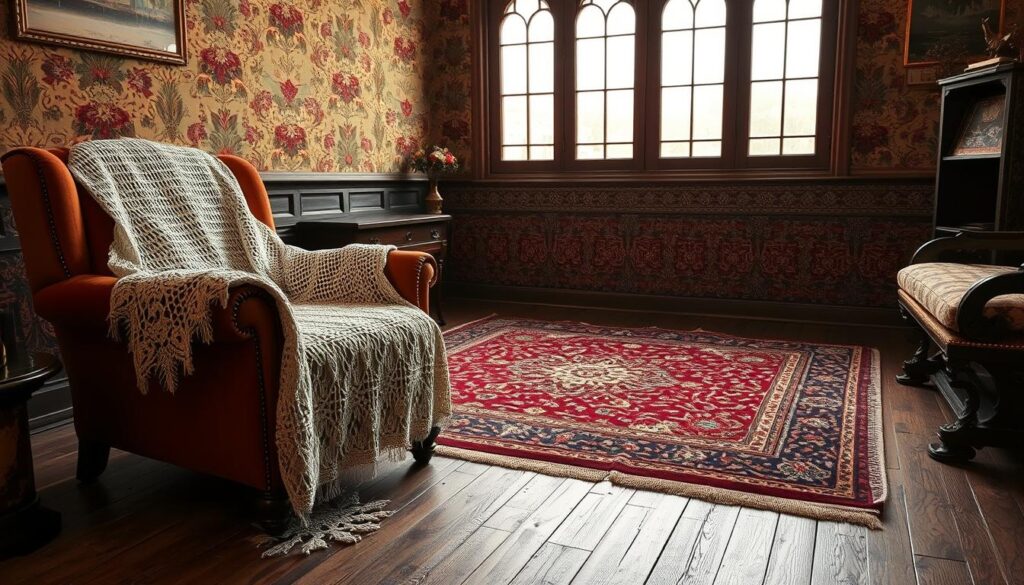
By using classic textiles and layering them thoughtfully, you can create a timeless colonial look. This look is both authentic and welcoming.
Architectural Features of Colonial Homes
Colonial home design is known for its architectural features. These elements, like fireplaces, mantels, windows, and doors, make these homes charming. They define the classic colonial look.
Fireplaces and Mantels
Fireplaces and mantels add warmth and character to colonial homes. They are not just for heating; they also decorate the space. Ornate mantels often have detailed carvings and are crafted from fine woods, enhancing the home’s classic charm.
The design of fireplaces and mantels shows the era’s skill. For example, a traditional colonial fireplace might have a mantel with classical motifs. This adds elegance to the room.
| Feature | Description | Significance |
|---|---|---|
| Fireplace Design | Often features classical elements and is made from stone or brick | Adds warmth and character to the room |
| Mantel Craftsmanship | Includes intricate carvings and is typically made from high-quality wood | Reflects the craftsmanship of the colonial era |
Windows and Doors
Windows and doors in colonial homes serve both function and beauty. Multi-paned windows are a key feature, letting in lots of natural light while keeping the home’s historic feel.
Doors in colonial homes often have classical details like pilasters and pediments. This adds to the home’s classic charm. The use of solid wood materials makes these elements durable and beautiful.
Understanding these architectural features helps us keep colonial homes charming. From the detailed mantels to the classic windows, each part is vital to the home’s look.
Lighting Options for Colonial Interiors
In colonial homes, lighting is more than just light. It brings history and tradition to life. The right lighting can make your space feel authentic and welcoming.
Choosing the right lighting for a colonial home is key. Look for both traditional fixtures and ways to let in natural light. These elements add to the room’s feel and look.
Chandeliers and Candle Holders
Chandeliers and candle holders were big in colonial homes. They brought light and elegance. Chandeliers, often made of brass or crystal, hung in key spots like dining rooms.
Candle holders were everywhere, adding warmth and soft light. When picking out chandeliers and candle holders, go for pieces that show off the era’s craftsmanship and materials. A crystal chandelier adds sophistication, while brass holders bring authenticity.
Natural Light Maximization
Letting in natural light is vital in colonial interiors. Homes had big windows with shutters or curtains. This let in lots of sunlight.
To get more natural light in your colonial home, try these tips:
- Use sheer curtains or blinds to let sunlight in while keeping things private.
- Make sure windows are clear of furniture or heavy drapes.
- Use mirrors or metallic finishes to reflect light and make rooms brighter.
| Lighting Element | Description | Benefit |
|---|---|---|
| Chandeliers | Often made from brass or crystal, hung in central areas. | Adds elegance and sophistication. |
| Candle Holders | Used throughout the home, made from materials like brass. | Provides warmth and soft light. |
| Natural Light | Maximized through large windows and sheer curtains. | Brightens the space, making it feel more welcoming. |
By using these lighting options and strategies, you can make your home feel warm and inviting. It will honor the traditional colonial style while meeting today’s needs.
Decorative Elements that Enhance Colonial Style
The colonial style is known for its classic decorations. To make your home look colonial, it’s important to know how to use these elements well.
Artwork and Accessories
Artwork and accessories are key in colonial home design. Choose items like antique prints, vintage maps, and classic portraits. They add depth and character to your space.
When picking artwork, look for frames that fit the colonial style. Frames with ornate details or gold leaf accents work well.
Accessories like vases, candlesticks, and decorative boxes also enhance the colonial look. Find items that show the era’s craftsmanship, like hand-carved wood or detailed metalwork. Interior design experts say it’s all about finding a balance between beauty and function.
“The right decorative elements can transport your home back in time, evoking the elegance and charm of the colonial era.”
Wall Treatments and Moldings
Wall treatments and moldings are crucial in traditional colonial decor. Crown moldings, chair rails, and paneling add sophistication. Choose these based on your home’s color palette and architecture for a cohesive look.
Adding classic colonial architecture elements, like wainscoting or raised panel doors, boosts your space’s authenticity. These details, as we discuss in classic colonial architecture, are vital for a timeless look.
By carefully choosing these decorative elements, you can create a colonial-style home that’s both elegant and welcoming. Whether you’re restoring a colonial home or just inspired by it, these elements will help you achieve a beautiful and authentic interior.
Embracing Open Layouts in Colonial Homes
Open layouts in colonial homes offer a chance to mix old charm with new needs. We need to keep the classic look of colonial homes while making them open and airy.
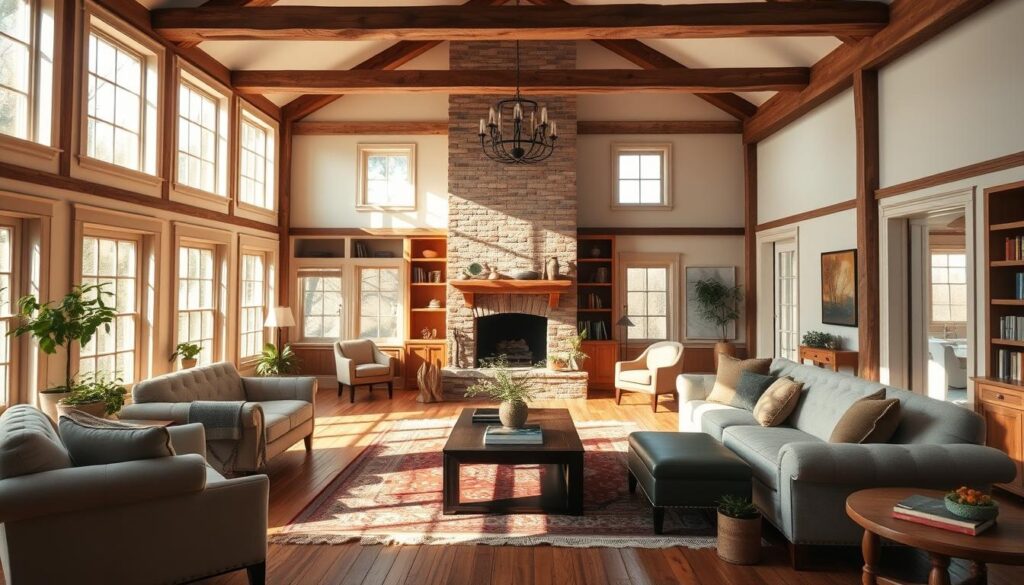
Balance Between Tradition and Functionality
It’s key to find a balance between old charm and new needs in open layouts. We can keep wooden moldings and fireplaces while making the space feel bigger.
To do this, we can take out walls that don’t carry weight. This makes the space feel larger. For example, opening the kitchen to the dining area improves flow without losing the traditional feel.
Tips for Room Flow
Good room flow is important in open layouts. We can use furniture placement to create different areas, like a living and dining space, without walls.
- Area rugs can help mark off different spaces in the open layout.
- Choose furniture that fits the colonial style but also meets today’s needs.
- Make sure the furniture is the right size for the space.
By carefully choosing these elements, we can make a colonial home that’s both timeless and practical. It meets today’s needs while honoring its history.
Incorporating Modern Amenities into Colonial Interiors
Mixing old colonial style with new comforts is a fun challenge. We aim to keep the charm of these homes while adding today’s conveniences.
To mix old and new well, we need to pick modern items that fit the colonial style. We should choose items that enhance the look, not overwhelm it.
Blending Old and New Design Elements
Choosing modern items with a classic look is key. For example, a modern range can fit in a traditional kitchen if it looks like it’s from the past.
Another smart move is to hide modern tech. Using smart home devices that you control with your phone or voice assistant keeps the look unchanged.
“The art of interior design is not just about creating a beautiful space, but also about crafting an experience that resonates with the inhabitants.”
Kitchen and Bathroom Updates
Kitchens and bathrooms need modern touches. But we must update them carefully to keep the home’s historic feel.
In kitchens, we can add modern appliances with a vintage look. Or, we can use sleek cabinets that look like they’re from the past. In bathrooms, we can add modern features like rain showerheads or heated floors. But we keep the classic look with materials like marble or brass.
| Area | Modern Update | Colonial Style Element |
|---|---|---|
| Kitchen | Modern Appliances | Vintage Finish |
| Bathroom | Rain Showerhead | Marble Countertops |
By carefully adding modern touches to colonial homes, we get the best of both worlds. We keep the charm and character of the past while enjoying today’s comforts.
Outdoor Spaces Reflecting Colonial Style
As we wrap up our look at colonial home design, let’s talk about outdoor areas. Colonial homes often had formal gardens and outdoor spaces that matched their style.
Gardens and Landscaping
To make an outdoor space feel colonial, think about using mirrored gardens, perennials, and flowering trees. These add to the colonial look and give a timeless feel.
Outdoor Furniture and Lighting
For outdoor furniture, pick pieces that are simple yet elegant, like colonial design. Use lantern-style lights, wall sconces, and post lights to add warmth. This makes your outdoor area feel connected to your home.
With these touches, we can make outdoor spaces that show off colonial style. They become peaceful places for both relaxing and having fun.

